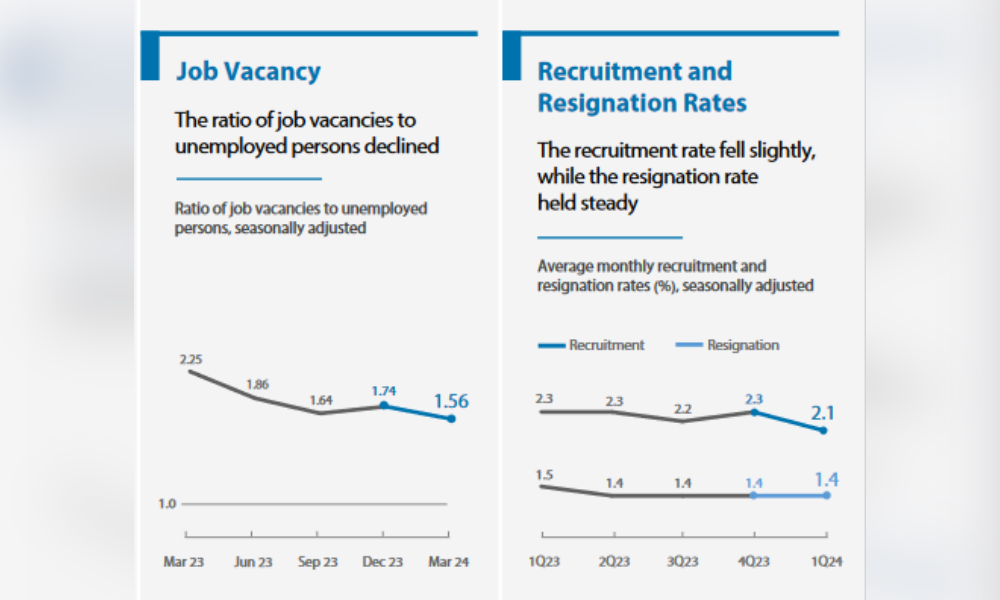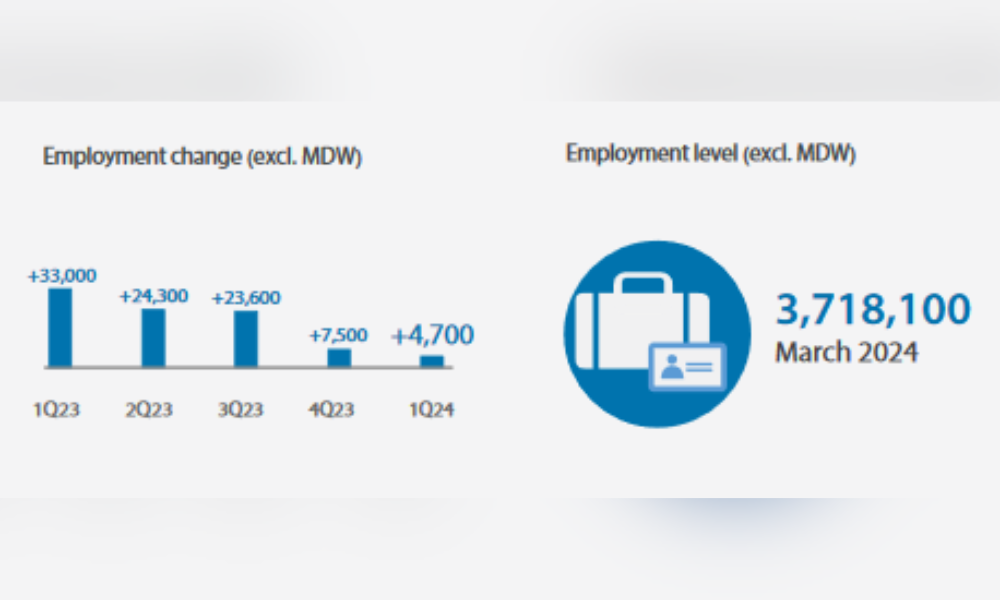
'More firms cited business reorganisation or restructuring as the reason for retrenchment,' says MOM

Singapore's labour market continued its expansion in the first quarter of 2024, albeit at a slower pace compared to the previous quarter.
The Ministry of Manpower reported a total employment growth of 4,700, driven entirely by a 5,500 increase in resident employment, while non-resident employment saw a decline of 800.
Looking forward, the government said it expects continued improvements in employment due to an improved economic outlook for 2024, sustained increases in job vacancies, and increased hiring optimism among firms.
"We do not expect increases in unemployment rates to be sustained as the number of retrenchments continued to ease, and resident employment growth had been positive in 1Q 2024."
The sectors leading the rise in resident employment included Financial & Insurance Services, Public Administration, Health & Social Services, Administrative & Support Services, and Education. These areas experienced higher resident employment changes compared to the fourth quarter of 2023.

Source: MOM
Conversely, resident employment in lower-paying sectors such as Retail Trade and Food & Beverages Services continued to decline following seasonal increases in the previous quarter, said the ministry in its report.
Non-resident employment saw its first decline since the third quarter of 2021, with significant decreases in the Construction and Manufacturing sectors. This drop was attributed to the implementation of a lower Dependency Ratio Ceiling for the Construction and Process sectors.
The Ministry noted that this trend is consistent with the economic performance of these sectors, which had seen positive growth for the past two years.
Unemployment rates edged up in March 2024, with the overall rate at 2.1%, the resident rate at 3.0%, and the citizen rate at 3.1%. The Ministry of Manpower explained, "The increase was not unexpected - we had previously highlighted that unemployment rates could edge up amid higher retrenchments in 3Q and 4Q 2023."
Despite the slight increase in unemployment, the rates remained within the range observed during non-recessionary periods. The resident long-term unemployment rate remained low at 0.8% in March 2024.

Source: MOM
The number of retrenchments continued to decline, dropping from 3,460 in the fourth quarter of 2023 to 3,030 in the first quarter of 2024. This decrease was largely due to fewer retrenchments in outward-oriented sectors such as Wholesale Trade and Electronics Manufacturing.
"More firms cited business reorganisation or restructuring as the reason for retrenchment in 1Q 2024, while retrenchments due to concerns of recession or downturn and high costs have declined," stated the Ministry of Manpower.
The number of job vacancies rose for the second consecutive quarter in March 2024, reaching 81,900, up from 79,800 in December 2023. This rise reflects improved economic prospects for 2024. However, the ratio of job vacancies to unemployed persons declined from 1.74 in December 2023 to 1.56 in March 2024, due to a slight increase in the number of unemployed persons.
Despite this, the labour market remained tight with more job vacancies than job seekers.
Job vacancies in growth sectors associated with higher productivity and pay, such as Health & Social Services, Information & Communications, Professional Services, and Financial & Insurance Services, formed nearly one-third of all job vacancies.
The recruitment rate fell slightly from 2.3% in the fourth quarter of 2023 to 2.1% in the first quarter of 2024, while the resignation rate held steady at 1.4%.
"This suggests that employees are staying for a longer period of time in any particular job," noted the Ministry of Manpower.
The decline in recruitment rates was mainly observed in the Construction sector and consumer-facing services such as Food & Beverage Services and Accommodation. Despite this decline, the recruitment rate in these sectors remained above the overall rate for the Services industry.